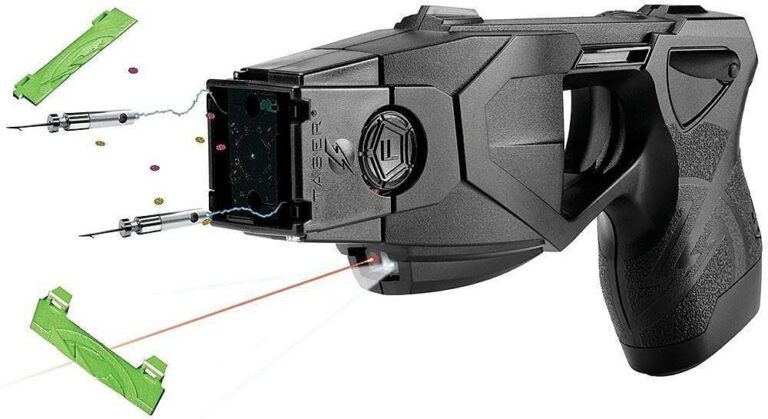Table of Contents
- Misidentification of Stun Guns in Law Enforcement Encounters Challenges Judicial Accuracy
- Impact of Erroneous Stun Gun Evidence on Defendant Rights and Case Outcomes
- Advancements in Forensic Technology Addressing Stun Gun Misidentification
- Policy Reforms and Training Enhancements Recommended to Prevent Future Discrepancies
- The Way Forward
Misidentification of Stun Guns in Law Enforcement Encounters Challenges Judicial Accuracy
Recent analyses of law enforcement encounters have spotlighted a troubling trend: the frequent misinterpretation of stun gun usage during criminal prosecutions. This confusion often results from the ambiguous visual evidence and incomplete reporting at incident scenes, leading to erroneous courtroom conclusions. Officers’ testimonies occasionally lack clarity, especially when distinguishing the deployment of stun guns from other forms of force, which complicates the judicial evaluation of self-defense claims and use-of-force justifications.
Key factors contributing to these misidentifications include:
- Similarities in physical handling and appearance between stun guns and conventional firearms.
- Insufficient video or photographic evidence, often impacted by poor lighting or camera angles.
- Variations in officers’ training regarding non-lethal weapon documentation and terminology.
Without precise identification, legal proceedings risk undermining the integrity of evidence and the fairness of trial outcomes. This highlights an urgent need for enhanced procedural protocols that ensure accurate capture and communication of stun gun usage, reinforcing both judicial accuracy and public trust in law enforcement accountability.
Impact of Erroneous Stun Gun Evidence on Defendant Rights and Case Outcomes
Errors in identifying the use of stun guns during criminal proceedings have led to significant challenges in protecting defendant rights. When stun gun evidence is misrepresented or inaccurately documented, it can unfairly sway jury perceptions, often painting the defendant as more violent or dangerous than reality supports. Such mischaracterizations have triggered wrongful convictions, prolonged litigation, and heightened appeals, undermining the judicial system’s commitment to fairness. Defendants faced with erroneous stun gun claims frequently endure an uphill battle in disproving false narratives, especially when law enforcement testimony conflicts or forensic analysis is lacking.
Key ramifications include:
- Compromised due process due to the introduction of unreliable or misleading physical evidence.
- Increased risk of harsher sentencing based on alleged use of excessive force, impacting parole eligibility and incarceration length.
- Undermining public trust in law enforcement and forensic credibility when mistakes are exposed.
- Strain on defense resources as attorneys must invest more time and cost to challenge faulty stun gun claims.
These outcomes demonstrate the critical need for rigorous validation of stun gun evidence through expert consultation and thorough investigative protocols. Only through accurate representation can courts ensure that defendants receive fair trials free from prejudicial errors.
Advancements in Forensic Technology Addressing Stun Gun Misidentification
Recent strides in forensic science have significantly enhanced the accuracy of identifying the use of stun guns in criminal investigations. Traditional methods often relied heavily on eyewitness testimony and basic physical evidence, both prone to error and misinterpretation. Now, cutting-edge technologies such as advanced thermal imaging, nanotechnology-based residue analysis, and improved electrochemical detectors are being deployed to distinguish between legitimate stun gun discharge and other sources of electrical or thermal signatures at crime scenes. These innovations not only improve the precision of detecting actual stun gun use but also reduce the risk of wrongful accusations stemming from misidentification.
Key developments supporting forensic accuracy include:
- Nanoparticle detection techniques capable of revealing microscopic traces unique to stun gun electrodes.
- Integration of high-definition thermal cameras providing real-time evidence of electrical pulses during incidents.
- Enhanced database systems that cross-reference chemical residues with known stun device profiles for rapid verification.
Policy Reforms and Training Enhancements Recommended to Prevent Future Discrepancies
To address the critical issue of stun gun misidentification in legal proceedings, policymakers must implement comprehensive reforms aimed at standardizing equipment identification protocols across law enforcement agencies. This includes mandatory adoption of certified tags and digital tracking systems for all electronic control devices, ensuring precise documentation from the moment of deployment to evidence presentation. Enhancing transparency in evidentiary handling not only strengthens prosecutorial accuracy but also reinforces public trust in justice administration.
Equally vital are targeted training improvements for both officers and judicial personnel. Law enforcement training curricula should emphasize distinguishing stun gun effects from other forms of restraint or assault, supported by scenario-based drills and updated forensic methodologies. Courts should receive dedicated workshops on interpreting electronic control device evidence, fostering an informed evaluation process. Key recommendations include:
- Mandatory certification programs for law enforcement on device identification and reporting.
- Integration of forensic experts specializing in electronic control devices into courtroom proceedings.
- Development of standardized evidentiary presentation guidelines to minimize subjective interpretation.
The Way Forward
The growing number of cases involving the misidentification of stun gun use highlights critical gaps in current law enforcement protocols and forensic analysis. As legal systems grapple with the implications of these errors, experts emphasize the urgent need for improved training, clearer guidelines, and advanced detection technologies to ensure accurate assessments in criminal investigations. Addressing these challenges is essential not only for safeguarding defendants’ rights but also for maintaining public trust in the justice system.Check Our Other Blogs
- StunGun – Your Trusted Source for Stun Guns, Laws, and Self-Defense Tips
- PepperSprayLaws – Your Trusted Resource for Pepper Spray Information
- StunGunLaws – Your Trusted Guide to Stun Gun Legality and Safety





